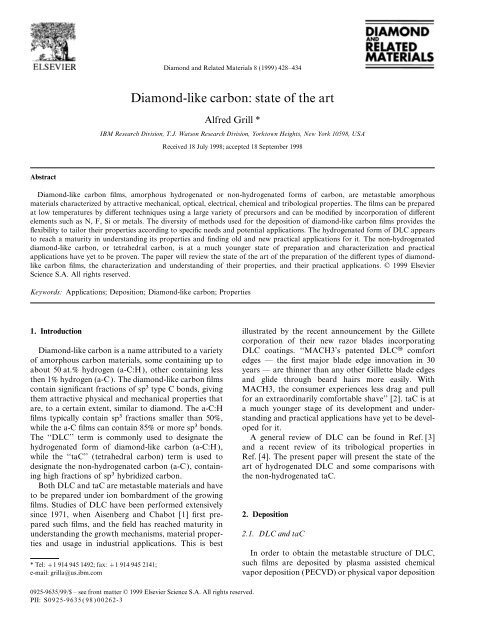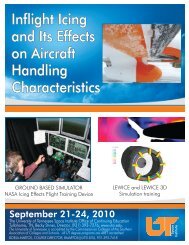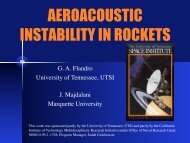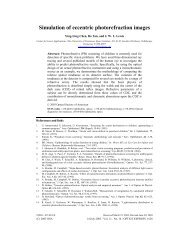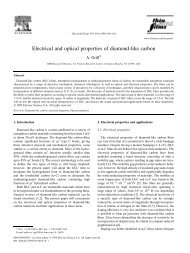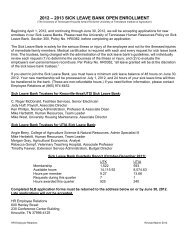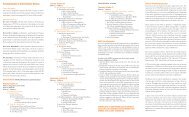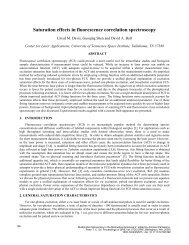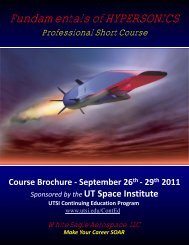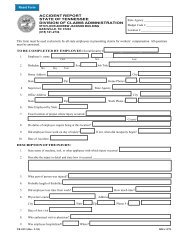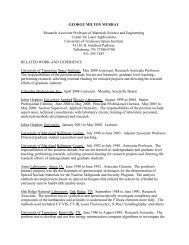Diamond-like carbon: state of the art
Diamond-like carbon: state of the art
Diamond-like carbon: state of the art
You also want an ePaper? Increase the reach of your titles
YUMPU automatically turns print PDFs into web optimized ePapers that Google loves.
<strong>Diamond</strong> and Related Materials 8 (1999) 428–434<br />
<strong>Diamond</strong>-<strong>like</strong> <strong>carbon</strong>: <strong>state</strong> <strong>of</strong> <strong>the</strong> <strong>art</strong><br />
Alfred Grill *<br />
IBM Research Division, T.J. Watson Research Division, Yorktown Heights, New York 10598, USA<br />
Received 18 July 1998; accepted 18 September 1998<br />
Abstract<br />
<strong>Diamond</strong>-<strong>like</strong> <strong>carbon</strong> films, amorphous hydrogenated or non-hydrogenated forms <strong>of</strong> <strong>carbon</strong>, are metastable amorphous<br />
materials characterized by attractive mechanical, optical, electrical, chemical and tribological properties. The films can be prepared<br />
at low temperatures by different techniques using a large variety <strong>of</strong> precursors and can be modified by incorporation <strong>of</strong> different<br />
elements such as N, F, Si or metals. The diversity <strong>of</strong> methods used for <strong>the</strong> deposition <strong>of</strong> diamond-<strong>like</strong> <strong>carbon</strong> films provides <strong>the</strong><br />
flexibility to tailor <strong>the</strong>ir properties according to specific needs and potential applications. The hydrogenated form <strong>of</strong> DLC appears<br />
to reach a maturity in understanding its properties and finding old and new practical applications for it. The non-hydrogenated<br />
diamond-<strong>like</strong> <strong>carbon</strong>, or tetrahedral <strong>carbon</strong>, is at a much younger <strong>state</strong> <strong>of</strong> preparation and characterization and practical<br />
applications have yet to be proven. The paper will review <strong>the</strong> <strong>state</strong> <strong>of</strong> <strong>the</strong> <strong>art</strong> <strong>of</strong> <strong>the</strong> preparation <strong>of</strong> <strong>the</strong> different types <strong>of</strong> diamond<strong>like</strong><br />
<strong>carbon</strong> films, <strong>the</strong> characterization and understanding <strong>of</strong> <strong>the</strong>ir properties, and <strong>the</strong>ir practical applications. © 1999 Elsevier<br />
Science S.A. All rights reserved.<br />
Keywords: Applications; Deposition; <strong>Diamond</strong>-<strong>like</strong> <strong>carbon</strong>; Properties<br />
1. Introduction illustrated by <strong>the</strong> recent announcement by <strong>the</strong> Gillete<br />
corporation <strong>of</strong> <strong>the</strong>ir new razor blades incorporating<br />
<strong>Diamond</strong>-<strong>like</strong> <strong>carbon</strong> is a name attributed to a variety DLC coatings. ‘‘MACH3’s patented DLC@ comfort<br />
<strong>of</strong> amorphous <strong>carbon</strong> materials, some containing up to edges — <strong>the</strong> first major blade edge innovation in 30<br />
about 50 at.% hydrogen (a-C:H), o<strong>the</strong>r containing less years — are thinner than any o<strong>the</strong>r Gillette blade edges<br />
<strong>the</strong>n 1% hydrogen (a-C ). The diamond-<strong>like</strong> <strong>carbon</strong> films and glide through beard hairs more easily. With<br />
contain significant fractions <strong>of</strong> sp3 type C bonds, giving MACH3, <strong>the</strong> consumer experiences less drag and pull<br />
<strong>the</strong>m attractive physical and mechanical properties that for an extraordinarily comfortable shave’’ [2]. taC is at<br />
are, to a certain extent, similar to diamond. The a-C:H a much younger stage <strong>of</strong> its development and under-<br />
films typically contain sp3 fractions smaller than 50%, standing and practical applications have yet to be developed<br />
while <strong>the</strong> a-C films can contain 85% or more sp3 bonds.<br />
for it.<br />
The ‘‘DLC’’ term is commonly used to designate <strong>the</strong> A general review <strong>of</strong> DLC can be found in Ref. [3]<br />
hydrogenated form <strong>of</strong> diamond-<strong>like</strong> <strong>carbon</strong> (a-C:H), and a recent review <strong>of</strong> its tribological properties in<br />
while <strong>the</strong> ‘‘taC’’ (tetrahedral <strong>carbon</strong>) term is used to Ref. [4]. The present paper will present <strong>the</strong> <strong>state</strong> <strong>of</strong> <strong>the</strong><br />
designate <strong>the</strong> non-hydrogenated <strong>carbon</strong> (a-C), containing<br />
<strong>art</strong> <strong>of</strong> hydrogenated DLC and some comparisons with<br />
high fractions <strong>of</strong> sp3 hybridized <strong>carbon</strong>.<br />
<strong>the</strong> non-hydrogenated taC.<br />
Both DLC and taC are metastable materials and have<br />
to be prepared under ion bombardment <strong>of</strong> <strong>the</strong> growing<br />
films. Studies <strong>of</strong> DLC have been performed extensively<br />
since 1971, when Aisenberg and Chabot [1] first prepared<br />
2. Deposition<br />
such films, and <strong>the</strong> field has reached maturity in<br />
understanding <strong>the</strong> growth mechanisms, material properties<br />
2.1. DLC and taC<br />
and usage in industrial applications. This is best<br />
In order to obtain <strong>the</strong> metastable structure <strong>of</strong> DLC,<br />
* Tel: +1 914 945 1492; fax: +1 914 945 2141;<br />
such films are deposited by plasma assisted chemical<br />
e-mail: grilla@us.ibm.com<br />
vapor deposition (PECVD) or physical vapor deposition<br />
0925-9635/99/$ – see front matter © 1999 Elsevier Science S.A. All rights reserved.<br />
PII: S0925-9635(98)00262-3
A. Grill / <strong>Diamond</strong> and Related Materials 8 (1999) 428–434<br />
429<br />
techniques (sputtering or ion beams) using a variety <strong>of</strong> films appears to reach a maximum at impinging p<strong>art</strong>icle<br />
precursors, as described in detail elsewhere [3]. In <strong>the</strong> energy <strong>of</strong> about 100 eV [9].<br />
PECVD methods, <strong>the</strong> substrates have to be at a negative<br />
bias relative to <strong>the</strong> plasma to achieve ion bombardment 2.2. Modified DLC and taC<br />
<strong>of</strong> <strong>the</strong> growing film. The deposition is performed in<br />
hydrogen-containing environments to obtain DLC films Various materials derived from <strong>the</strong> diamond-<strong>like</strong><br />
containing 10–50 at.% hydrogen. The hydrogen is <strong>carbon</strong> films have been developed to change and improve<br />
required for obtaining ‘‘diamond-<strong>like</strong>’’ properties in <strong>the</strong>ir properties. Such materials are similar in structure<br />
<strong>the</strong>se materials. It determines <strong>the</strong> film structure, passivates<br />
to DLC or taC but, in addition to <strong>carbon</strong> and/or<br />
<strong>the</strong> dangling bonds in <strong>the</strong> amorphous structures, hydrogen, include nitrogen (NDLC or CN films), sili-<br />
x<br />
thus controlling <strong>the</strong> optical and electrical properties, con (SiDLC), silicon and oxygen, fluorine (FDLC),<br />
and affects <strong>the</strong> internal stresses <strong>of</strong> <strong>the</strong> films. In most and metal atoms (MeDLC). Most modifications have<br />
cases <strong>the</strong> deposition is a line-<strong>of</strong>-sight technique and <strong>the</strong> been made to DLC to reduce its, typically high, internal<br />
film is deposited on only one surface <strong>of</strong> <strong>the</strong> substrate. compressive stresses (N, Si, metal incorporation), to<br />
Industrial tools based on this technique have been reduce its surface energy [14] for fur<strong>the</strong>r lowering, its<br />
developed and are used in manufacturing. Deposition already low, friction coefficients (F, Si–O incorporation)<br />
<strong>of</strong> DLC films by a high density plasma in a helical [3,4,15], or to modify its electrical properties [16,17].<br />
resonator PECVD process has also been reported [5]. Nitrogen incorporation has been used to improve field<br />
The growth and properties <strong>of</strong> DLC films are controlled emission properties <strong>of</strong> both DLC and taC [18,19]. Si<br />
by <strong>the</strong> substrate temperature and bias, <strong>the</strong> latter having incorporation in DLC has been found useful in reducing<br />
<strong>the</strong> dominant control [3]. The hardness, density and <strong>the</strong> etching rate <strong>of</strong> DLC in oxygen plasma and makes<br />
refractive index <strong>of</strong> <strong>the</strong> films increase with increasing it useful as an etch stop for undoped DLC [16]. The<br />
substrate bias. The deposition rates also usually increase modified diamond-<strong>like</strong> <strong>carbon</strong> films are deposited by<br />
with increasing bias. Even for films deposited in a helical <strong>the</strong> same techniques as <strong>the</strong> regular films by adding<br />
resonator, <strong>the</strong> substrates had to be biased negatively to species containing <strong>the</strong> modifying elements to <strong>the</strong> depos-<br />
obtain diamond-<strong>like</strong> properties. Films deposited in this ition environment and details can be found in <strong>the</strong><br />
reactor on grounded substrates had polymeric characteristics<br />
references cited above.<br />
[5].<br />
A more recent technique for deposition <strong>of</strong> DLC films<br />
is <strong>the</strong> plasma source ion implantation (PSII) [6]. In this 3. Properties<br />
technique, <strong>the</strong> substrates are placed directly in a plasma<br />
source and <strong>the</strong>n pulse-biased. This is a non-line-<strong>of</strong>-sight 3.1. Structure<br />
technique and enables <strong>the</strong> coating <strong>of</strong> complex structures.<br />
Ano<strong>the</strong>r non-line-<strong>of</strong>-sight technique for deposition <strong>of</strong> <strong>Diamond</strong>-<strong>like</strong> <strong>carbon</strong> films are amorphous materials<br />
DLC has been demonstrated in an ionitriding tool in with <strong>carbon</strong> atoms bonded in mainly sp3 and sp2 hybridwhich<br />
DLC has been deposited by bipolar-pulsed DC izations. <strong>Diamond</strong>-<strong>like</strong> <strong>carbon</strong> is a low-mobility semiconductor,<br />
PECVD [7]. The films have been found to have properties<br />
with a bandgap <strong>of</strong> 1–4 eV, room temperature<br />
similar to RF PECVD-deposited films, with <strong>the</strong> photoluminiscence and low electron affinity [20]. The<br />
advantage <strong>of</strong> being deposited in an existing industrial properties <strong>of</strong> <strong>the</strong> films are determined by <strong>the</strong> relative<br />
reactor.<br />
ratio <strong>of</strong> <strong>the</strong> two hybridizations. DLC films can have<br />
The superhard properties <strong>of</strong> taC films are achieved sp3 fractions up to about 40% [21], while taC can reach<br />
by <strong>the</strong> high energies <strong>of</strong> <strong>the</strong> impinging p<strong>art</strong>icles that form sp2 fractions <strong>of</strong> up to 87% when deposited at ion energies<br />
<strong>the</strong> films. It is assumed that in this case <strong>the</strong> films grow <strong>of</strong> about 100 eV [9,22]. Angus and Jahnsen [23] have<br />
by subplantation, instead <strong>of</strong> by <strong>the</strong> conventional conden- described <strong>the</strong> structure <strong>of</strong> hydrogenated DLC by a<br />
sation, as in <strong>the</strong> case <strong>of</strong> DLC films [8]. The required random covalent, fully constrained, network model.<br />
high energies <strong>of</strong> <strong>the</strong> depositing species are achieved by According to this model, <strong>the</strong> DLC structure can be<br />
different variations <strong>of</strong> vacuum or cathodic arc discharges,<br />
described as a three-dimensional array <strong>of</strong> mostly six-<br />
such as filtered arc [9], pulsed arc [10], laser membered rings, which is able to contain 17–61 at.%<br />
controlled arc [8,10], pulsed laser depositions [8,11] or bound hydrogen. The role <strong>of</strong> hydrogen in controlling<br />
mass selected ion beams [12]. Vacuum arc discharges <strong>the</strong> properties <strong>of</strong> DLC has been discussed in detail<br />
can cause local overheating <strong>of</strong> <strong>the</strong> cathode and microspaling,<br />
elsewhere [3,24].<br />
resulting in deposition <strong>of</strong> rough films. Such Robertson [25] modeled <strong>the</strong> structure <strong>of</strong> diamond-<br />
problems can be overcome by <strong>the</strong> mentioned modifications<br />
<strong>like</strong> <strong>carbon</strong> in 1986 as a random network <strong>of</strong> covalently<br />
<strong>of</strong> <strong>the</strong> techniques to deposit smooth and very hard bonded <strong>carbon</strong> atoms in <strong>the</strong> different hybridizations,<br />
taC films. The PSII technique can also be used for <strong>the</strong> with a substantial degree <strong>of</strong> medium range order on <strong>the</strong><br />
deposition <strong>of</strong> taC films [13]. The sp3 fraction in <strong>the</strong> taC 1 nm scale. In a recent refinement <strong>of</strong> his model,
430 A. Grill / <strong>Diamond</strong> and Related Materials 8 (1999) 428–434<br />
Roberston describes <strong>the</strong> structure <strong>of</strong> both DLC and taC internal stresses. These properties are directly correlated<br />
as being controlled by <strong>the</strong> energy <strong>of</strong> <strong>the</strong> p bonding <strong>of</strong> to <strong>the</strong> fraction <strong>of</strong> sp3 C in <strong>the</strong> films. The hardness <strong>of</strong><br />
<strong>the</strong> sp2 sites [20]. According to Robertson, <strong>the</strong> p bonding DLC films is in <strong>the</strong> range 10–30 GPa [28], with a<br />
<strong>of</strong> <strong>the</strong> sp2 <strong>carbon</strong> favors clustering <strong>of</strong> sp2 sites to corresponding Young’s modulus 6–10 times larger. The<br />
maximize <strong>the</strong> p-bonding energy. The sp2 sites can gain films are characterized by internal compressive stresses<br />
fur<strong>the</strong>r energy by forming sixfold planar ‘‘aromatic’’ in <strong>the</strong> range 0.5–7 GPa. The stresses can be reduced by<br />
rings and fusing <strong>the</strong> rings into larger graphitic clusters. incorporating N, Si, O or metals in <strong>the</strong> films [13,24],<br />
However, <strong>the</strong> energy gain resulting from increasing although <strong>the</strong> reduction in stresses is <strong>of</strong>ten associated<br />
cluster size beyond pairing is small, <strong>the</strong>refore, <strong>the</strong> cluster with a reduction in hardness and elastic modulus <strong>of</strong><br />
size remains small. For planar graphitic clusters <strong>of</strong> sp2 <strong>the</strong> films.<br />
<strong>carbon</strong>, <strong>the</strong> band gap was found to be given by The hardness <strong>of</strong> taC films can reach higher values (in<br />
E =6/M1/2 eV, where M is <strong>the</strong> number <strong>of</strong> sixfold rings<br />
g <strong>the</strong> range <strong>of</strong> 40–80 GPa) [8,22], and <strong>the</strong>ir Young’s<br />
in <strong>the</strong> cluster [25]. According to Robertson, <strong>the</strong> small<br />
modulus can reach values up to 900 GPa [10], but <strong>the</strong><br />
sp2 clusters cannot explain <strong>the</strong> small bandgap <strong>of</strong> DLC<br />
stress can also reach high values up to 13 GPa [22]. The<br />
and <strong>the</strong> small bandgap is caused by <strong>the</strong> fact that <strong>the</strong><br />
high internal stresses limit <strong>the</strong> thickness <strong>of</strong> films that<br />
distorted clusters have much smaller bandgaps [20]. The<br />
can be used for any application, <strong>of</strong>ten to less than 1 mm<br />
bandgap is <strong>the</strong>refore controlled by <strong>the</strong> distortion <strong>of</strong> <strong>the</strong><br />
thick. The stresses in taC have been reduced by incorpoclusters<br />
and not <strong>the</strong>ir size. Robertson also found that<br />
ration <strong>of</strong> metals [13] or by building multilayered struc<strong>the</strong><br />
optical gap <strong>of</strong> all types <strong>of</strong> diamond-<strong>like</strong> <strong>carbon</strong>,<br />
tures comprising s<strong>of</strong>t and hard films using a filtered<br />
hydrogenated or non-hydrogenated, depends mainly on<br />
<strong>the</strong> sp2 fraction in <strong>the</strong> films and decreases with increastion<br />
[29,30]. The bias <strong>of</strong> <strong>the</strong> substrate was changed<br />
vacuum arc and varying <strong>the</strong> ion energy during composi-<br />
ing sp2 fraction. Non-hydrogenated taC, which has<br />
small sp2 fractions, has a very rigid network, while<br />
between −100 eV (to obtain <strong>the</strong> hardest layers with an<br />
hydrogenated DLC has a s<strong>of</strong>ter polymeric network, yet sp3 fraction <strong>of</strong> 85% and hardness <strong>of</strong> 60 GPa) and −2kV<br />
both types <strong>of</strong> films have similar bandgaps.<br />
(to deposit s<strong>of</strong>t films with an sp3 fraction <strong>of</strong> 39%) [30].<br />
The multilayered structures had hardness (40–23 GPa)<br />
3.2. Characterization<br />
and modulus (350–245 GPa), corresponding to <strong>the</strong> fraction<br />
<strong>of</strong> <strong>the</strong> hard and s<strong>of</strong>t layers, and <strong>the</strong> stresses in <strong>the</strong><br />
The structural characterization <strong>of</strong> diamond-<strong>like</strong> films were reduced in <strong>the</strong> multilayered films from<br />
<strong>carbon</strong> films is complicated by <strong>the</strong>ir amorphous nature. 10.5 GPa, for <strong>the</strong> hard film, to 3.8 GPa, for <strong>the</strong> film<br />
High resolution nuclear magnetic resolution (NMR) containing a 90% s<strong>of</strong>t fraction.<br />
spectroscopy with its recent refinements [21] appears to<br />
be <strong>the</strong> best technique for characterization <strong>of</strong> <strong>the</strong> <strong>carbon</strong> 3.4. Material stability<br />
hybridization <strong>of</strong> hydrogenated DLC. Fourier transform<br />
infrared spectroscopy (FTIR) is still being used by some Both <strong>the</strong> hydrogenated and non-hydrogenated DLC<br />
authors to quantify <strong>the</strong> <strong>carbon</strong> hybridization ratios and are metastable materials and <strong>the</strong>ir structures will change<br />
hydrogen content in DLC films, in spite <strong>of</strong> <strong>the</strong> fact that towards graphite-<strong>like</strong> <strong>carbon</strong> by ei<strong>the</strong>r <strong>the</strong>rmal activait<br />
has been shown that <strong>the</strong> technique can give erroneous tion or irradiation with energetic photons or p<strong>art</strong>icles.<br />
information [26]. Electron energy loss spectroscopy Heating <strong>of</strong> hydrogenated DLC films results in <strong>the</strong> loss<br />
(EELS) has become <strong>the</strong> established method to measure <strong>of</strong> hydrogen and CH species, st<strong>art</strong>ing at about 400 °C,<br />
<strong>the</strong> sp2 bonding fraction in non-hydrogenated taC [20].<br />
x<br />
or even lower, depending on <strong>the</strong> deposition conditions<br />
The technique is, however, not suitable for DLC, which<br />
and <strong>the</strong> dopant contained in <strong>the</strong> films [3,16,17]. This<br />
is sensitive to irradiation with an electron beam [27].<br />
causes changes in <strong>the</strong> dimensions and properties <strong>of</strong> <strong>the</strong><br />
FTIR can be used for qualitative characterization <strong>of</strong><br />
material and limits <strong>the</strong> use <strong>of</strong> DLC in applications<br />
different bonds in hydrogenated diamond-<strong>like</strong> <strong>carbon</strong><br />
involving temperatures above 400 °C. The temperature<br />
films or <strong>the</strong>ir modifications. Film compositions can be<br />
at which changes take place in <strong>the</strong> DLC films appears<br />
determined by Ru<strong>the</strong>rford backscattering (RBS) analyto<br />
be correlated to <strong>the</strong> power used for <strong>the</strong> preparation<br />
sis <strong>of</strong> C and heavier elements and forward recoil elastic<br />
scattering (FRES) for H concentrations. Mechanical<br />
<strong>of</strong> <strong>the</strong> films [16]. The <strong>the</strong>rmal instability <strong>of</strong> DLC films<br />
properties are usually determined by nanoindentation<br />
is generally associated with <strong>the</strong> loss <strong>of</strong> hydrogen, result-<br />
measurements for hardness and Young’s modulus detersp2-bonded<br />
network.<br />
ing in a collapse <strong>of</strong> <strong>the</strong> structure into a mostly<br />
mination and measurements <strong>of</strong> radius <strong>of</strong> curvature <strong>of</strong><br />
coated substrates for stress determination [3,22].<br />
It has been reported that <strong>the</strong>rmal activation can also<br />
induce changes in taC films and cause <strong>the</strong> conversion <strong>of</strong><br />
3.3. Mechanical properties<br />
some sp3 <strong>carbon</strong> bonds to sp2 bonds [31]. The onset <strong>of</strong><br />
relaxation st<strong>art</strong>ed at temperatures as low as 100 °C and<br />
<strong>Diamond</strong>-<strong>like</strong> <strong>carbon</strong> films are characterized by high near full relaxation has been observed at 600 °C. An<br />
hardness and a high elastic modulus, but also by high activation energy in <strong>the</strong> range <strong>of</strong> 1–3 eV has been
A. Grill / <strong>Diamond</strong> and Related Materials 8 (1999) 428–434<br />
431<br />
reported for this <strong>the</strong>rmal relaxation [31]. The <strong>the</strong>rmal DLC may have a lower stability <strong>the</strong>n taC because <strong>of</strong><br />
relaxation reduced <strong>the</strong> internal stresses <strong>of</strong> <strong>the</strong> taC films <strong>the</strong> hydrogen content [18].<br />
and increased <strong>the</strong>ir electrical conductivity. However, it DLC coatings have also been found to increase <strong>the</strong><br />
has been claimed at <strong>the</strong> present conference that taC emission current from metallic FED tips [36]. Nitrogen<br />
films can be stable at least up to temperatures <strong>of</strong> 600 °C. incorporation in DLC coatings can enhance this effect.<br />
The diamond-<strong>like</strong> <strong>carbon</strong> films can also be changed Thus, a 20 nm PECVD-deposited NDLC coating was<br />
by UV [32] or ion beam irradiation [33]. Irradiation <strong>of</strong> found to enhance <strong>the</strong> emission current from Spindt type<br />
DLC in air with UV irradiation from a high pressure Mo tips <strong>of</strong> a FED from 160 to 1520 mA [19]. The<br />
mercury lamp was found to break C–C and C–H bonds surface roughness <strong>of</strong> <strong>the</strong> films can strongly affect <strong>the</strong><br />
and cause oxidation <strong>of</strong> <strong>the</strong> film with formation <strong>of</strong> C–O field emission effects <strong>of</strong> DLC, as was observed for DLC<br />
bonds [32]. CO ,CH and H evolved from <strong>the</strong> film films deposited by laser ablation [11].<br />
2 4 2<br />
during <strong>the</strong> irradiation, resulting in a reduction <strong>of</strong> film In spite <strong>of</strong> said above, it now appears that <strong>the</strong> field<br />
thickness. UV irradiation <strong>of</strong> NDLC films containing emission from diamond-<strong>like</strong> <strong>carbon</strong>, or o<strong>the</strong>r forms <strong>of</strong><br />
about 11 at.% nitrogen resulted in a decrease in C–H <strong>carbon</strong> films, is not related to electron affinity <strong>of</strong> <strong>the</strong><br />
bonding and an increase in C–C, CNN and CON materials, but is controlled instead by <strong>the</strong> nano-level<br />
bonds. The sp2 cluster size in <strong>the</strong> films became smaller, roughness <strong>of</strong> <strong>the</strong> films.<br />
<strong>the</strong>refore, <strong>the</strong> optical gap increased. NDLC films with<br />
high N content (~37 at.%) did not show any FTIR<br />
changes after UV irradiation [32]. However, <strong>the</strong>ir optical 3.6. Tribology<br />
gap increased, indicating a reduction <strong>of</strong> <strong>the</strong> cluster size<br />
in <strong>the</strong> absence <strong>of</strong> material loss.<br />
The widest use <strong>of</strong> diamond-<strong>like</strong> <strong>carbon</strong> films is mainly<br />
Room temperature irradiation <strong>of</strong> taC films with an <strong>of</strong> <strong>the</strong> hydrogenated DLC in applications exploiting <strong>the</strong><br />
ion beam <strong>of</strong> 200 keV Xe+ transformed <strong>the</strong> material into low friction coefficients and high wear-resistance <strong>of</strong> <strong>the</strong>se<br />
a conducting amorphous <strong>carbon</strong> with an sp2 fraction <strong>of</strong> materials. It is <strong>the</strong>refore natural that a lot <strong>of</strong> efforts<br />
0.6. At higher temperatures, <strong>the</strong> same irradiation have been invested in <strong>the</strong> characterization <strong>of</strong> <strong>the</strong> tribological<br />
properties <strong>of</strong> DLC. A recent review <strong>of</strong> <strong>the</strong><br />
increased <strong>the</strong> sp2 fraction to about 0.8 and increases <strong>the</strong><br />
degree <strong>of</strong> ordering towards a graphitic material [33].<br />
tribological properties <strong>of</strong> DLC films and <strong>the</strong>ir modified<br />
forms [4] shows that, in all environments, <strong>the</strong> tribological<br />
behavior <strong>of</strong> DLC is controlled by an interfacial<br />
transfer layer formed during friction. The transfer layer<br />
3.5. Field emission<br />
is formed by a friction-induced transformation <strong>of</strong> <strong>the</strong><br />
In <strong>the</strong> quest for finding new applications for diamond<strong>like</strong><br />
top layer <strong>of</strong> <strong>the</strong> DLC film into a material <strong>of</strong> low shear<br />
<strong>carbon</strong>, a significant effort has been directed in <strong>the</strong> strength. This transformation may be caused by friction-<br />
last few years to <strong>the</strong> investigation <strong>of</strong> <strong>the</strong> field emission induced annealing, caused by <strong>the</strong>rmal and strain effects<br />
properties <strong>of</strong> DLC or taC. Flat panel field emission generated during sliding [37]. The shear strength <strong>of</strong> <strong>the</strong><br />
displays (FED) use sharp Mo or Si tips for emission <strong>of</strong> transfer layer and its adhesion to sliding surfaces can<br />
electrons for <strong>the</strong> excitation <strong>of</strong> phosphor screen pixels. be affected by <strong>the</strong> environment and by contact load and<br />
The sharp tips are needed to obtain <strong>the</strong> high electric sliding speed. The composition <strong>of</strong> <strong>the</strong> transfer layer can<br />
field required to extract <strong>the</strong> electrons from <strong>the</strong>se materi- also be affected by <strong>the</strong> material <strong>of</strong> <strong>the</strong> sliding counterp<strong>art</strong>.<br />
als which are characterized by a high work function <strong>of</strong><br />
The low friction and ultra low wear <strong>of</strong> DLC and<br />
about 5 eV. The hydrogenated surface <strong>of</strong> diamond has counterp<strong>art</strong>s can be explained by <strong>the</strong> low shear strength<br />
a negative electron affinity, <strong>the</strong>refore diamond or diamond-<strong>like</strong><br />
<strong>of</strong> <strong>the</strong> transfer layer [4], which can also be affected by<br />
<strong>carbon</strong> films have <strong>the</strong> potential to serve as <strong>the</strong> testing environment [38].<br />
electron emitters for FEDs, without needing <strong>the</strong> 1 mm A compilation <strong>of</strong> friction coefficients <strong>of</strong> DLC films<br />
lithography for <strong>the</strong> preparation <strong>of</strong> sharp tips [34]. It [39] shows that <strong>the</strong> friction coefficients <strong>of</strong> DLC span a<br />
was found that <strong>the</strong> threshold field for electron emission range <strong>of</strong> m=0.007–0.4, in vacuum below 10−4 Pa, while<br />
in <strong>the</strong> taC films reaches a minimum <strong>of</strong> about in ambient air at relative humidities <strong>of</strong> 20%
432 A. Grill / <strong>Diamond</strong> and Related Materials 8 (1999) 428–434<br />
to be above a threshold <strong>of</strong> about 40 at.% to obtain very 10−7 mm3 N−1 m−1, however <strong>the</strong> wear rate had a minimum<br />
low friction coefficients in ultra high vacuums [41,42].<br />
<strong>of</strong> about 3×10−8 mm3 N−1 m−1 for a multilayer<br />
Metal-containing DLC films have been found to modulated film containing 50% s<strong>of</strong>t phase [29].<br />
reduce friction and wear, not only in sliding, but also<br />
in vibrating contacts for a broad range <strong>of</strong> testing condi- 3.7. DLC materials as low-k dielectrics<br />
tions [43]. Fluorinated DLC with high F and low H<br />
content having wear resistance similar to pure DLC has Special interest has recently been addressed to <strong>the</strong><br />
been demonstrated [15]. Because <strong>of</strong> <strong>the</strong> <strong>the</strong>rmal instabil- dielectric constant (k) <strong>of</strong> DLC and FDLC films<br />
ity <strong>of</strong> DLC films, <strong>the</strong>ir wear behavior is temperature [17,46,47]. Low-k materials are needed for <strong>the</strong> back<br />
sensitive and that sensitivity will be affected by <strong>the</strong> end <strong>of</strong> <strong>the</strong> line (BEOL) interconnect structures <strong>of</strong> ULSI<br />
deposition conditions <strong>of</strong> <strong>the</strong> studied films. For some ( Ultra Large Scale Integrated) circuits to improve <strong>the</strong>ir<br />
films, <strong>the</strong> wear behavior in ambient air has been found performance. It was found that, by adjusting <strong>the</strong> deposto<br />
change with temperature in <strong>the</strong> range 100–300 °C, ition conditions, it is possible to obtain DLC films with<br />
with both <strong>the</strong> friction coefficient and wear resistance <strong>the</strong> dielectric constant in <strong>the</strong> range 2.7–3.8 and FDLC<br />
decreasing with increasing temperature [44].<br />
films with dielectric constants k15% hydrogen, while p<strong>art</strong>icle emis- decrease, but so also does <strong>the</strong> <strong>the</strong>rmal stability, with<br />
sions were detected also in films containing lower con- decreasing k values [16].<br />
centrations <strong>of</strong> hydrogen. The tribo-emission was FDLC films with dielectric constants k
A. Grill / <strong>Diamond</strong> and Related Materials 8 (1999) 428–434<br />
433<br />
Table 1<br />
Summary <strong>of</strong> properties and applications <strong>of</strong> diamond-<strong>like</strong> <strong>carbon</strong> films. Text in paren<strong>the</strong>ses indicates potential applications<br />
Property Type <strong>of</strong> use Applications<br />
Transparency in Vis and IR; Optical coatings Antireflective and wear-resistant coatings for IR optics<br />
optical bandgap=1.0–4.0 eV<br />
Chemical inertness to acids, Chemically passivating coatings Corrosion protection <strong>of</strong> magnetic media, biomedical<br />
alkalis and organic solvents<br />
High hardness; H=5–80 Gpa: Tribological, wear-resistant coatings Magnetic hard drives, magnetic tapes,<br />
low friction coefficient=
434 A. Grill / <strong>Diamond</strong> and Related Materials 8 (1999) 428–434<br />
Ano<strong>the</strong>r variation <strong>of</strong> <strong>the</strong> diagram <strong>of</strong> Fig. 1 is presented [29] J.W. Ager, III, S. Anders, I.G. Brown, M. Nastasi, K.C. Walter,<br />
Surf. Coat. Technol. 91 (1997) 91.<br />
in Fig. 2 (after Ref. [60]), which shows that <strong>the</strong> dia-<br />
[30] S. Anders, D.L. Callahan, G.M. Pharr, T.Y. Tsui, C.S. Bhatia,<br />
mond-<strong>like</strong> <strong>carbon</strong> films, comprising sp3, sp2 and even Surf. Coat. Technol. 9495 (1997) 189.<br />
sp1 <strong>carbon</strong> bonds, have ranges <strong>of</strong> properties delimited [31] S. Reinke, W. Kulisch, Surf. Coat. Technol. 97 (1997) 23.<br />
by <strong>the</strong> properties <strong>of</strong> diamond, graphite and polymers. [32] M. Zhang, Y. Nakayama, J. Appl. Phys. 82 (1997) 4912.<br />
These ranges <strong>of</strong> properties <strong>of</strong> hydrogenated and non- [33] D.G. McCulloch, D.R. McKenzie, S. Prawer, A.R. Merchant,<br />
E.G. Gerstner, R. Kalish, Diam. Relat. Mater. 6 (1997) 1622.<br />
hydrogenated diamond-<strong>like</strong> <strong>carbon</strong> are summarized in<br />
[34] J. Robertson, Mater. Res. Soc. Symp. Proc. 471 (1997) 217.<br />
Table 1, toge<strong>the</strong>r with existing and potential applications [35] G.A.J. Amaratunga, S.R.P. Silva, Appl. Phys. Lett. 68 (1996) 2529.<br />
based on <strong>the</strong> specific properties <strong>of</strong> <strong>the</strong> material.<br />
[36] J.H. Jung, B.K. Ju, Y.H. Lee, M.H. Oh, J. Jang, in: Proceedings<br />
<strong>of</strong> <strong>the</strong> Sixteenth International Display Research Conference, Birmingham,<br />
UK, 1–3 October 1996, Soc. Inf. Display, (SID), New<br />
York, USA, 1996, p. 203.<br />
References<br />
[37] A. Erdemir, C. Bindal, J. Pagan, P. Wilbur, Surf. Coat. Technol.<br />
7677 (1995) 559.<br />
[38] C. Donnet, M. Belin, J.C. Auge, J.M. M<strong>art</strong>in, A. Grill, V. Patel,<br />
[1] S. Aisenberg, R. Chabot, J. Appl. Phys. 42 (1971) 2953.<br />
Surf. Coat. Technol. 6869 (1994) 626.<br />
[2] Business Wire, April 14, 1998.<br />
[39] C. Donnet, Cond. Matter News 4 (1995) 9.<br />
[3] A. Grill, B. Meyerson, in: K.E. Spear, J.P. Dismukes (Eds.), Syn-<br />
[40] C. Donnet, T. Le Mogne, L. Ponsonnet, M. Belin, A. Grill, V.<br />
<strong>the</strong>tic <strong>Diamond</strong>: Emerging CVD Science and Technology, Wiley, Patel, C. Jahnes, Tribology Lett. 4 (1998) 259.<br />
New York, 1994, p. 91. [41] C. Donnet, A. Grill, Surf. Coat. Technol. 94–95 (1997) 456.<br />
[4] A. Grill, Surf. Coat. Technol. 9495 (1997) 507. [42] C. Donnet, A. Grill, J. Fontaine, T. Le Mogne, F. Lefebvre, V.<br />
[5] J.Y. Shim, E.J. Chi, H.K. Baik, S. Lee, Jap. J. Appl. Phys. 37 Patel, C. Jahnes, 1998, to be published in Proc. <strong>of</strong> 25th Leeds–<br />
(1998) 440. Lyon Symp. on Tribology, 8–11 Sept. 1998, Lyon, France.<br />
[6] R.S. Lillard, D.P. Butt, T.N. Taylor, K.C. Walter, M. Nastasi, [43] D. Klaffke, A. Skopp, Surf. Coat. Technol. 98 (1998) 953.<br />
Corros. Sci. 39 (1997) 1605.<br />
[44] A. Vanhulsel, B. Blanpain, J.P. Celis, J. Roos, E.S. Dekempeneer,<br />
[7] T. Michler, M. Grishke, I. Traus, K. Bewilogua, H. Dimigen, Surf. Coat. Technol. 98 (1998) 1047.<br />
Diam. Relat. Mater. 7 (1998) 459.<br />
[45] K. Nakayama, B. Bou Said, H. Ikeda, Trans. ASME J. Tribology<br />
[8] B. Schultrich, H.J. Scheibe, D. Drescher, H. Ziegele, Surf. Coat. 119 (1997) 764.<br />
Technol. 98 (1998) 1097.<br />
[46] A. Grill, V. Patel, S.A. Cohen, D.C. Edelstein, J.R. Paraszczak,<br />
[9] M. Chhowalla, C.W. Chen, B. Kleinsorge, J. Robertson, G.A.J. C. Jahnes, in: R. Haveman, J. Schmitz, H. Komiyama, K. Tsubouchi<br />
Amaratunga, W.I. Milne, Mater. Res. Soc. Symp. Proc. 423<br />
(Eds.), Advanced Metallization and Interconnect Systems<br />
(1996) 299.<br />
for ULSI Applications in 1996, Materials Research Society, Pitts-<br />
[10] H.J. Scheibe, B. Schultrich, H. Ziegele, P. Siernroth, IEEE Trans.<br />
burg, PA, 1997, p. 417.<br />
Plasma Sci. 25 (1997) 685.<br />
[47] K. Endo, T. Tatsumi, Y. Matsubara, T. Horiuchi, Mater. Res.<br />
[11] Y.K. Hong, J.J. Kim, C. Park, J.S. Kim, J.K. Kim, J. Vac. Sci.<br />
Soc. Symp. Proc. 443 (1997) 165.<br />
Technol. B Microelectron Nanometer Struct. 16 (1998) 729. [48] A. Grill, C. Jahnes, J. Ott, V. Patel, J. Hummel, R. Mih, J. Liu,<br />
[12] Y. Lifshitz, Diam. Relat. Mater. 5 (1996) 388.<br />
The Electrochemical Soc. Proc. Series 98 (3) (1998) 118.<br />
[13] O.R. Monteiro, M.P. Delplancke-Ogletree, I.G. Brown, [49] P. Koidl, A. Bubenzer, B. Dischler, Symp. Opt. Surf. Technol.<br />
AgerJ.W., III, Mater. Res. Soc. Symp. Proc. 438 (1997) 599.<br />
Proc. Soc. Photo-Opt. Instr. Eng. 381 (1983) 186.<br />
[14] M. Grishke, A. Hieke, F. Morgenweck, H. Dimigen, Diam. Relat. [50] A. Lettington, in: P. Koidl, P. Oelhafen (Eds.), Amorphous<br />
Mater. 7 (1998) 454.<br />
Hydrogenated Carbon Films, Proc. Eur. Mater. Res. Soc. Symp.,<br />
[15] C. Donnet, J. Fontaine, A. Grill, V. Patel, C. Jahnes, M. Belin,<br />
Les Editions de Physique, Paris, 1987, p. 359.<br />
Surf. Coat. Technol. 9495 (1997) 531.<br />
[51] F.M. Kimock, B.J. Knapp, Surf. Coat. Technol. 56 (1993) 273.<br />
[16] A. Grill, V. Patel, K.L. Saenger, C. Jahnes, S.A. Cohen, A.G.<br />
[52] EDGE: Work-Group Computing Report, May 11, 1998.<br />
Schrott, D.C. Edelstein, J.R. Paraszczak, Mater. Res. Soc. Symp.<br />
[53] Thin Film/<strong>Diamond</strong> Technology News, October 1, 1997.<br />
Proc. 443 (1997) 155.<br />
[54] A.C. Callegari, K. Babich, S. Purushothaman, S. Mansfield, R.<br />
[17] A. Grill, V. Patel, C. Jahnes, J. Electrochem. Soc. 145 (1998) 1649.<br />
Ferguson, A. Wong, W. Adair, D. O’Grady, V. Chao,<br />
Microelectron. Eng. 4142 (1998) 107.<br />
[18] W.I. Milne, J. Robertson, B.S. Satyanarayanan, A. H<strong>art</strong>, Mater.<br />
[55] A.H. Lettington, in: Y. Tzeng, M. Yoshikawa, M. Murakawa, A.<br />
Res. Soc. Symp. Proc. 471 (1997) 217.<br />
Feldman (Eds.), Applications <strong>of</strong> <strong>Diamond</strong> Films and Related<br />
[19] J.H. Jung, B.K. Ju, H. Kim, M.H. Oh, S.J. Chung, J. Jang, J. Vac.<br />
Materials, Materials Science Monographs, Elsevier, New York,<br />
Sci. Technol. B Microelectron Nanometer Struct. 16 (1998) 705.<br />
1991, p. 703.<br />
[20] J. Robertson, Philos. Mag. B Phys. Condens. Matter Stat. Mech.<br />
[56] A.C. Evans, J. Franks, P.J. Revell, Surf. Coat. Technol. 47<br />
Electron. Opt. Magn. Prop. UK 76 (1997) 335.<br />
(1991) 662.<br />
[21] C. Donnet, F. Lefebvre, A. Grill, J. Fontaine, V. Patel, C. Jahnes,<br />
[57] C.J. McHargue, in: Y. Tzeng, M. Yoshikawa, M. Murakawa, A.<br />
1998, to be published in J. Appl. Phys.<br />
Feldman (Eds.), Applications <strong>of</strong> <strong>Diamond</strong> Films and Related<br />
[22] X. Shi, D. Flynn, B.K. Tay, S. Prawer, K.W. Nugent, S.R.P. Materials, Materials Science Monographs, Elsevier, New York,<br />
Silva, Y. Lifshitz, W.I. Milne, Philos. Mag. B Phys. Condens. 1991, p. 113.<br />
Matter Stat. Mech. Electron. Opt. Magn. Prop. UK 76 (1997) [58] D. Devlin, D. Carroll, R. Barbero, J. Klawitter, P. Strzepa, W.<br />
351. Ogilivie, in: B. Simons (Ed.), ASME International Mechanical<br />
[23] J.C. Angus, F. Jansen, J. Vac. Sci. Technol. A 6 (1988) 1778. Engineering Congress and Exposition, Proceedings 1997, ASME,<br />
[24] A. Grill, IBM J. Res. Develop., 43 (1–2), in press (1999). Bioengineering Division, Fairfield, NJ, USA, 1997, p. 265.<br />
[25] J. Robertson, Adv. Phys. 35 (1986) 317. [59] Electronic Engineering Times, December 8, PG381, 1997.<br />
[26] A. Grill, V. Patel, Appl. Phys. Lett. 60 (1992) 2089. [60] P. Koidl, C. Wild, R. Locher, R.E. Sah, in: R.E. Clausing, L.L.<br />
[27] L. Ponsonnet, C. Donnet, J.M. M<strong>art</strong>in, A. Grill, V. Patel, Thin Horton, J.C. Angus, P. Koidl (Eds.), <strong>Diamond</strong> and <strong>Diamond</strong>-<br />
Solid Films 319 (1998) 97.<br />
<strong>like</strong> Films and Coatings, NATO-ASI Series B: Physics, Plenum,<br />
[28] J. Robertson, Surf. Coat. Technol. 50 (1992) 185.<br />
New York, 1991, p. 243.


